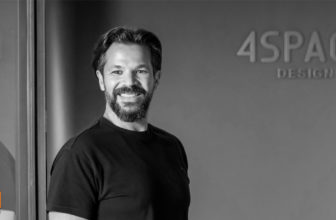Founded in 1999, nARCHITECTS is an architecture office founded in New York City by Principals Eric Bunge and Mimi Hoang. The work of the office encompasses architecture, urban design, and interiors, with a goal of uniting strategic thinking, environmental and social commitment, and technical innovation. nARCHITECTS brings an open-ended approach to the design process based on conceptual clarity and technical innovation. Complex client identities, layered sites and phasing requirements are unpacked and reframed as straightforward design opportunities.
Ongoing work includes the design of the Wyckoff House Museum in Brooklyn, Ellicott Park at the Buffalo Niagara Medical Campus, Pierscape at Chicago’s Navy Pier, a competition-winning project led by James Corner Field Operations, and the firm’s competition-winning entry for the groundbreaking adAPT NYC competition to design a micro unit building in Manhattan.
nARCHITECTS has been ranked 10th in Design in the 2015 Architect 50, and 9th in 2016. The office has many other recognitions including their selection in 2012 as a Highly Commended firm in the international WAN (World Architecture News) 21FOR21 competition “to be part of a select group crowned to lead the next generation of designers in the 21st century.” That same year, Wallpaper Magazine named nARCHITECTS one of twenty “world’s most intriguing young practices,” in their Architects Directory 2012.
Arch2O had the opportunity to interview Mimi Hoang, who is a co-founding Principal of nARCHITECTS, and an Adjunct Assistant Professor at the Graduate School of Architecture, Planning and Preservation at Columbia University GSAPP. Mimi received a Master of Architecture from Harvard University and a Bachelor of Science in Architecture from M.I.T. Prior to founding nARCHITECTS, she trained in New York, Boston, and Amsterdam. Mimi has also taught at Yale University, Harvard University, and UC Berkeley. Mimi Hoang has a wide range of projects in many cities of the world including United States, Canada, Taiwan, Lebanon, Toronto, France, searching for diversity and flexibility while implementing latest innovative solutions with a minimum effort and budget. Read the edited version of the transcript of the interview with Mimi Hoang below:
- In your own words can you tell us how nARCHITECTS started and what were the projects that had a major impact on the Studio’s progress and development?
Well, we started doing competitions that were about critically rethinking program and building types. For a while we were experimenting with competitions and also trying to build small. Those two interests – rethinking building concepts and also trying to build however possible – has always been our goal. I would say the two projects that had the first impact on the studio were ‘Canopy ’, for MoMA P.S.1, which was the installation in green bamboo and then ‘Switch Building’ in Manhattan. With the former, we were trying to reconceptualize what a program / building type was, and with the latter, we tried to find ways to innovate within a very known building type – the apartment building. So with MoMA P.S.1 we were experimenting with ways of building using non-standard building materials like bamboo, and experimenting with ideas about creating different kind of spaces for different activities without creating hard boundaries. We thought of the MoMA/P.S.1 Canopy installation as an ‘almost building’, where we explored different ways of occupying space. This idea of an almost building refers to something that changes or something that is incomplete, maybe waiting for completion by its user or by its context, something that is ambiguous. That idea is still with us and we are constantly thinking about these qualities even as we work on our more traditional commissions. The projects that have a big impact right now are Carmel Place (NYC’s first micro-unit apartment building) and Chicago Navy Pier. We worked on the Navy Pier project as part of James Corner Field Operation’s team, on a very large renovation of the three thousand foot-long pier in Chicago. We designed all the architecture structures on the pier and focused on how architecture engages with its context – whether it’s an urban context or landscape context. Carmel Place and Chicago Navy Pier were just completed and are setting the current direction of the office.
- What are the reasons that made you want to study architecture and pursue your career as an architect?
My partner Eric and I both had similar interests as kids to draw, tinker and make things. I think that is why a lot of people go into architecture. At a very basic level, we are interested in people occupying and interacting with our work. We say we like to be a fly on the wall of our work – for our public projects, there is nothing more rewarding than watching people interact, occupy and appropriate, or even misappropriate and misuse, what we have to designed. We have a general desire to improve how people interact with their environment and with each other.
- The New York’s first micro-apartment tower was criticized on the ground that it would affect the user’s health badly as the amount of daylight and ventilation is estimated to be lower than the normal apartment size. How would you reply to such views? And do you think micro-apartments are the best solution to affordable housing crisis in New York?
[In regards to the lower levels of daylight and ventilation], it is not true. What we shrank was the footprint of the apartments, but what we increased and magnified was ceiling height and the amount of light and air. The project tests whether or not we should shrink the allowable square foot area of an apartment from the previous minimum of four hundred sq. feet. The apartments in Carmel Place range between 270 to 370 sq. ft. net with a ceiling height of 9 feet 8 inches, which is well above the typical average of 8 feet. If you compare the volume of a 400 sq. ft. apartment with 8 ft. tall ceilings with that of a 300 sq. ft. apartment with 9 feet 8 inch ceilings, the volume of ours is only ten per cent smaller. It is interesting to think about volume because all New Yorkers know how to maximize the height of their apartments and to go vertical with storage and with many aspects of living. We also designed oversize windows – actually 8 feet tall sliding doors – which means that the amount of light and air far exceeds the minimum code, so the apartments feel much bigger. And the bathrooms and kitchens have a normal ceiling height, at 8 feet, which allows for additional overhead storage. Do I think it is the best solution? It is one of many solutions that we need and frankly it is not all about the design of just micro-units, but about the variety and mix needed in affordable housing. So yes, it is a good solution for a certain percentage of the population – maybe the very young, or divorcees or the elderly, who want to downsize their living space in order to gain back in terms of social interaction and a closer connection to their community. But there are so many other things like policy, development incentives, transportation infrastructure, etc. that need to change in order to tackle the amount of affordable housing that we need.
- Do you have contemporaries or precedent individuals who you look to for inspiration in architecture?
I’ll give you examples from two different slices of time. We have always been inspired by Lina Bo Bardi, the Italian – Brazilian architect. We have always admired her approach to building because she has always been very close to her Brazilian context in terms of materials and how one builds there. I would offer her as an example of an experimental, Modernist architect who is closely tied to the local culture, local materials, local building processes, etc. At the opposite end of the spectrum, we admire a lot of contemporary Japanese architects, like SANAA, who are pushing the boundaries of what a building is. Their kind of experimentation in glass, density and proximity of structures are literally asking questions of where should a building begin and end and does it need to be so resolved?
- Today, the architectural market is saturated and it’s not easy to find a job. What advice would you give to fresh graduates, also what qualifications do you look for in students that aspire to join your team?
Anyone that has gone through an architecture education hopefully by the end would have figured out that it takes up an enormous amount of work and energy and optimism. When we are reviewing candidates we look for the same; an enormous amount of creative energy; an enormous amount of creative production in terms of experimenting with all the ways that you need to draw and represent and build your architecture; and an enormous amount of positive optimism. You need a really thick skin and a lot of positive energy to keep pushing and to keep on searching and to keep trying to do good work, because it just takes that. And I would say to graduates there is a very big difference between school and practice. School is all about you and your own voice, practice is about what you can bring to the firm how and what you going to contribute, how are you going to move the needle forward in term of the firm’s work.





